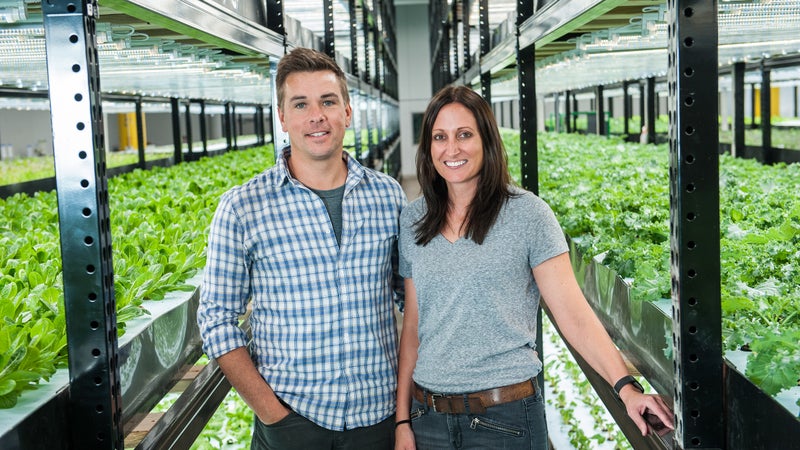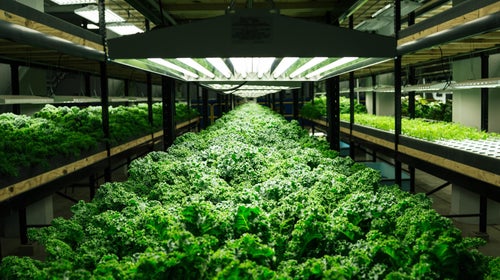Urban Organics Wants to Fix Food
Inside a repurposed Twin Cities brewery, a massive aquaponics operation is ready to provide a locavore's dream: fresh produce and fish, raised indoors every month of the year
New perk: Easily find new routes and hidden gems, upcoming running events, and more near you. Your weekly Local Running Newsletter has everything you need to lace up! .
On a cold, breezy morning in March 2017, I found myself shivering in a half-empty parking lot outside the entrance to the century-old Schmidt brewery in Saint Paul, Minnesota. The brick-walled landmark appeared abandoned. Beer hasn’t flowed through its industrial arteries since 2002, when brewing ceased permanently. Its whitewashed grain silos were yellowed and rust-stained; the chimney stack that once billowed fragrant, hops-scented steam had been capped.
But a rebirth was underway here, one that has nothing to do with cheap lager. It was happening inside an empty 85,000-square-foot warehouse once used for storing kegs. That’s where I stood waiting for Fred Haberman, the then 51-year-old cofounder of , who pulled up in a black Porsche Cayenne E-Hybrid.
“It’s sooo easy to recharge,” he proclaimed, leaping out to praise its electric-hybrid engine. “I can plug it into a regular outlet. In. My. House.” Haberman adores anything that smacks of sustainability. If it’s good for the climate, the environment, or the planet, well then by God sign him up.
Haberman runs a successful marketing agency that bears his name, which has worked with foodie clients like Annie’s Homegrown, Earthbound Farm, and Organic Valley, along with Prana, Volvo, and LeafLine Labs, a medical-cannabis outfit that manufacturers pharmaceutical-grade THC and CBD extracts. He launched Urban Organics in 2011 with three friends and a plan, among other things, to create the world’s largest organic aquaponics farm. Aquaponics combines hydroponics—growing plants without soil in a water-based mineral solution—with aquaculture, otherwise known as fish farming. Poop-laden wastewater from the fish is pumped into the plant beds, where roots suck up the nutrients and help purify the sullied water before it’s recirculated back to the aquaculture tanks.
When I first met Haberman in early 2017, all he wanted to talk about was pond hockey. “It’s my religion.”
An early form of aquaponics was developed by the Toltecs, who created artificial islands (called chinampas) to grow crops on lakes. More recently, maker types have been getting into it, cobbling together smallish home setups. But the Urban Organics operation is massive. This became obvious when Haberman stopped talking about his SUV and prodded me through the front door of the Schmidt building and into the warehouse.
It was humid inside and smelled peaty, like a temperate rain forest but with four million pea-sized suns—glowing LEDs affixed to power strips above thriving beds of arugula, kale, Swiss chard, and more. In a space roughly the size of a Costco, there were more than 300,000 individual plants. Today there are some four million sprouting from grow racks stacked five stories high. Fish were in there, too—some 100,000 rainbow trout and 100,000 arctic char doing laps inside eight open tanks, each seven feet deep. One million gallons of water was flowing through this Urban Organics farm—from fish to plants and back again. Because it’s a closed-loop system, virtually no water is wasted except for a tiny amount (about 2 percent) lost to evaporation.
The yields can be tremendous: when I visited, 16,000 pounds of greens were being harvested every week. Output like that is a locavore’s dream, especially in Minnesota, where regional produce is scarce during the protracted, frigid winter. Restaurants, corner groceries, supermarkets, and a major hospital—all located in the Twin Cities—couldn’t get enough of the stuff.
The implications of a system like this are enormous. In the modern economy, most fresh produce is trucked vast distances, typically from California and Mexico in diesel-fueled refrigerated semitrailers. Seafood travels even farther, coming from places like Vietnam and Indonesia. The distribution costs associated with shipping food can add 25 percent to the final shelf price.
The Urban Organics model reduces this expense, while subsequently slashing the carbon footprint of farming. “Almost all our customers do pickup,” Haberman told me. “We only own a few trucks.” His products are also immune to droughts, floods, and other global-warming weirdness.
Haberman’s hope, he said, was to erect similar facilities elsewhere “to decentralize the food system and eradicate hunger. And to prove that you can take a distressed physical asset like a brewery and make it part of turning a neighborhood around.” It all sounds very heroic and visionary until we start talking about how to profit from this grand endeavor. “We’re still proving the model,” Haberman concedes. “But if it does what it looks like on paper, you’re going to see a lot more of these farms.”

Perhaps. But it’s worth noting that Urban Organics still isn’t profitable. Nearly two years after my visit—by which time Haberman had left the company to launch yet another startup, , which sells gourmet organic sauces and spreads—I checked in with Urban Organics general manager Dave Haider, who told me that the company isn’t currently in the black. He blames this partly on an aquaculture snafu: Initially he started fish farming with 100,000 Atlantic salmon. But the attempt to farm salmon indoors was wildly ambitious and had never been done successfully in commercial aquaculture. The fry contracted a disease and the effort was scuttled.
“We had to dispose of all of them,” Haider informed me, noting that salmon—even farmed-raised—still prefer an outdoor venue. Since the company switched to trout and char, Haider said, things have been going swimmingly. Once they’re full grown, he expects to reap about 7,000 pounds of fish each week, cycling in new fry to replace the harvested adults. Anticipating an uptick in sales, Haider has more than doubled his staff since my visit, from 15 to 40 employees.
While Haider wouldn’t reveal the company’s current or projected revenue, he exuded confidence. “As we are one of the first aquaponics farms to operate at this scale, we are constantly learning and adjusting our model,” he said. “While there have been setbacks, such as the switch from salmon to trout and char, overall we are on track with our profitability goals.”
When I first met Haberman in early 2017, all he wanted to talk about was pond hockey. “It’s my religion,” he said of the game he plays with his buddies several times a week on Minnesota’s frozen lakes. In 2006, he founded the . “We soon had 20,000 people showing up with over 1,000 teams,” he told me over dinner at the Birchwood Café in Minneapolis, where we shared a plate of fried tilapia and a kale and arugula salad—all Urban Organics fare, grown just eight miles away.
Haberman sold the championships in 2010 to a group of fellow players, at which point his partner at his marketing firm urged him to take a break from getting into any new businesses for at least a year. Haberman heeded the advice, sort of, and began researching food deserts. These are low-income areas devoid of groceries or farmer’s markets, where residents have inadequate access to fresh food—a plight that affects almost 24 million Americans.
Meanwhile, Haider, a former stonemason who once made backyard ponds and waterfalls, and who had been responsible for prepping the ice for Haberman’s hockey events, became intrigued by aquaponics after his wife, Kristen, alerted him to a local TV news segment about Will Allen, a former professional basketball player during the seventies. A longtime pioneer in outdoor urban agriculture, Allen, the son of a sharecropper, was by then delving into aquaponics. The story inspired Haider, who thought that aquaponics would make a fun hobby. He cobbled together a crude setup in his basement to grow tomatoes and lettuce, nourished by the fecal droppings of two tilapia in an adjacent tank.
“Anyhoo,” continued Haberman, forgoing dessert for a pint of pale ale, “I get wind of Dave and Kristen looking into aquaponics and I go, ‘Oh my God, I’m interested in this as well!’ And they say, ‘Let’s partner up.’” Kristen had already left an HR job at the Minnesota Department of Agriculture. Then the Haiders’s friend and neighbor Chris Ames signed on, becoming their finance and real estate guy. None of the founders had any experience with large-scale aquaponics farming, but as Haberman put it, “We had this naivete that we could give it a varsity try and will it to succeed.”
So in 2011, the partners purchased their first keg warehouse, in the vacant . Haider hired the first employee, Anthony Johannes, and together they constructed the entire facility in just over a year, making countless supply trips to Home Depot. The Hamm’s space was Urban Organics’ pilot farm. (It’s about a tenth of the size of the Schmidt operation, built four years later.) “Breweries are great for aquaponics, as they need a source of water, which we have in the form of well houses on site,” Haider explained. “They also have strong foundations built to handle large volumes of liquid.”

When it came time to stock the Hamm’s fish farm, Haider and Johannes found a deal on tilapia at a hatchery located in Apopka, Florida, some 1,500 miles away. They flew there from Minnesota, rented a U-Haul, outfitted it with three 500-gallon tanks, and made the 36-hour trek back to the Hamm’s facility with 600 baby tilapia sloshing around in the back. “I came in at six in the morning and Kristen says, ‘You smell like a dead fish,’” Haider said. “I had been riding in that truck for a day and a half.”
When I visited the Hamm’s operation in 2017, it was producing 150 pounds of fish per week and 1,000 pounds of produce per month. Two employees were perched on stepladders with paring knives, carefully shearing leaves of arugula and red kale. The salad mix was packaged in five-ounce clamshell containers and sold for $3.99 at local supermarkets. Haider offered me a piece of fresh-cut arugula. It tasted almost effervescent, with a peppery kick. “This industry needs a success story,” he said, “And it hasn’t had one yet on this scale.”
Pentair is a $7.2 billion public corporation with its main U.S. main offices based in Minneapolis. (The global headquarters is in London.) It makes water treatment systems for residential and commercial applications, including food production and swimming pools. Randy Hogan was Pentair’s CEO from 2001 until his retirement last year. When I spoke to him in April 2017, he told me he’d heard about people jury-rigging his company’s products for home aquaponics systems. And he’d watched a few modest-size aquaponics operations try and fail to create commercially viable farms. “Fred Haberman said, ‘I know these folks Dave and Kristen who have this idea and they want to move out of their basement,’” Hogan said. “They were the classic hobbyists.”
Pentair had already ventured beyond its established pump and filter trade into rainwater recycling; the system it installed at Target Field, the ballpark for the Minnesota Twins, was the first and largest at a sports stadium at the time. With Urban Organics, Pentair was prepared to take aquaponics more seriously.
Last summer, not long after Hogan left its helm, Pentair purchased Urban Organics outright for an undisclosed sum. To most, that may seem like a speculative investment. But while Hogan was still at the company, he argued otherwise, believing that it was the opportune moment for aquaponics. “We don’t waste water, we use electricity efficiently, we use nutrients efficiently, and we don’t have to transport the product very far,” he said at the time. “We will see this being replicated in other cities.” In the meantime, he characterized Urban Organics as a working R&D lab.
Aquaponics startups had approached Hogan before, though none intrigued him as much as the Schmidt brewery concept, chiefly because it was so large. “The Hamm’s production level was not where we could have a large impact in the community,” he said. “Schmidt’s is ten times larger, almost like corporate farming, and we were really intrigued with scaling up.” Pentair put up virtually all the money and equipment—about $15 million in capital investment—to build the Schmidt farm. This included a sophisticated indoor fish hatchery with eight 500-gallon tanks for hatching trout and char eggs.

Haider showed me a few other things that Pentair’s backing helped pay for. One is a robotic-looking contraption that automatically injects plant seeds into little tufts of shredded coconut husk used for germinating greens. Another is a specially designed fish pump for sucking up live trout and char when they’re ready to be transferred from the nursery to the “grow out” tanks. There’s also a clever pest-control system: every month, about 40,000 parasitic insects—wasps, ladybugs, and mites—are released into the facility, where they set forth devouring anything that might want to nibble on the precious edible greens.
During my visit, Haider walked me over a span of elevated metal grates that sit four feet above a raging indoor river. What looked like Class IV rapids was actually a state-of-the-art filtration system. It’s outfitted with various mechanical, biological, UV, and ozone sterilization technologies to convert ammonia from fish poop into stuff that plants like to eat, such as nitrates and phosphates. The only byproduct is a black sludge that Urban Organics stuffs into plastic sacks and hopes to sell as organic fertilizer. “It would make us the first zero-waste indoor farm,” Haider pointed out.
During my tour, Haberman was uncharacteristically silent. He was content playing the wizard behind the curtain, quietly waiting for my reaction as he walked me through what legitimately is an impressive operation. Occasionally, though, Haberman chimed in with declarations like, “I have a dream that we would have half-million-square-foot facilities like this in locations around the world.” But Haberman was getting ahead of himself.
Aquaponics farming on the scale that Urban Organics is attempting is still almost unheard of. In fact, when Kristen requested organic certification from the U.S. Department of Agriculture through a local agency, the forms she received had little relevance to aquaponics, with most questions directed at conventional farming. As a result, she helped the agency develop an aquaponics-specific application.
When I visited, 16,000 pounds of greens were being harvested every week. Output like that is a locavore’s dream, especially in Minnesota, where regional produce is scarce during the protracted, frigid winter.
At one point, Haberman compared aquaponics to the work of Steve Jobs and Bill Gates. “You knew something powerful was going to come from their work,” he said. “I feel the same way about aquaponics. In ten to twenty years, you’re going to see these operations everywhere.”
While Haberman has moved on from Urban Organics, when I spoke with him again in January 2019, he remained emphatic that aquaponics is a key component of the future of food. That vision might seem improbable to the tractor and-plow folks still muscling crops from sprawling 500-acre farms, vulnerable to the whims of weather and the price of diesel. But like any revolution, perspective is often generational. “We have a nine-year-old daughter,” says Kristen. “When she was younger, if you asked her to draw a farm, she drew a brick building with fish and plants inside.”


